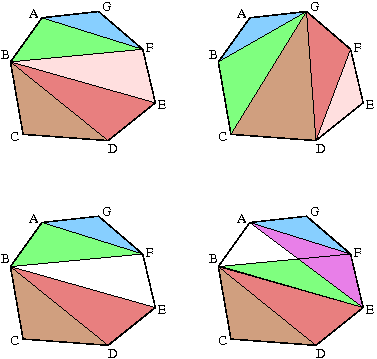CS 5114 Homework 4 (Spring 2008)
Assigned on Wednesday, February 27, 2008. Email PDF to me or
submit hardcopy at my office by 5pm on Wednesday, March 5,
2008.
Describe your algorithms as clearly as possible. The style used
in the book is fine, as long as your description is not ambiguous.
Do not make any assumptions not stated in the problem. If you do
make any assumptions, state them clearly, and explain why the
assumption does not decrease the generality of your solution. If you
use any new words or phrases, define them, especially if we have not
used these words/phrases in class. Do not describe your
algorithms only for a specific example you may have worked out. You
must also provide a clear proof that your solution is correct (or a
counter-example, where applicable). Describe an analysis of your
algorithm and state its running time.
- (15 points) Solve exercise 1 in Chapter 6 (pages 312-313) of
your textbook.
- (30 points) Solve exercise 12 in Chapter 6 (pages 323-324) of
your textbook.
- (15 points) Solve exercise 17 in Chapter 6 (pages 327-328) of
your textbook.
- (40 points) A convex polygon is a polygon where very interior
angle is less than 180 degrees. A museum is in the shape of a
convex polygon with n vertices. The museum is patrolled
by guards. The Directory of Security at the museum has the
following rules to ensure the most safety in as time-economical
a way as possible:
- Each guard traverses a path in the shape of a
triangle; each vertex of such a triangle must a vertex of
the polygon.
- A guard can survey all the points inside his or her triangle
and only these points; we say that these points are
covered by the guard.
- Every point inside the museum must be covered by some guard.
- The triangles traversed by any pair of guards do not
overlap in their interiors, although they may
share a common edge.
Given these constraints, the cost incurred by a guard
is the length of the perimeter of the triangle the guard
traverses. Our goal is to find a set of guards such that the
total cost of the guards (i.e., the sum of the costs of the
individual gaurds) is as small as possible. Devise an algorithm
whose running time is polynomial in n to solve this
problem. Note that we are not trying to minimise the number of
guards; we want to minimise the total lengths of the routes
patrolled by the guards.

Above are four figures that illustrate the problem. The museum is
the polygon ABCDEFG. Each coloured (shaded) triangle corresponds
to a guard and the guard will traverse the perimeter of his or
her triangle.
-
The top two figures show a set of guards (their triangles)
that satisfy the constraints laid down by the Directory of
Security. In the top left figure, the guards traverse the
boundaries of triangles AFG (blue), ABF (green), BEF (pale
red), BDE (light red), and BCD (brown). In the top right
figure, the guards traverse ABG (blue), BCG (green), CDG
(brown), DFG (light red), and DEF (pale red).
- The bottom two figures show a set of triangle that do
not satisfy these constraints: in the figure on the
bottom left, part of the museum is not covered by any guard
(the unshaded triangle BEF) while in the figure on the
bottom right, the pink triangle (AEF) and the green triangle
(BEF) intersect (not that the part of the green triangle is
covered by the pink triangle).
